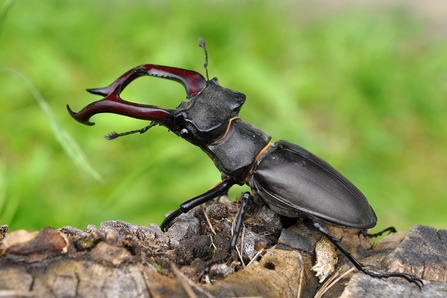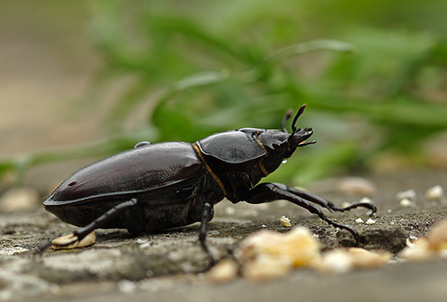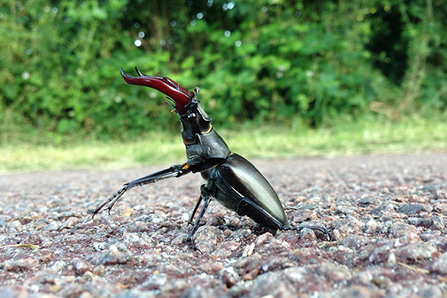
Stag beetle - Adobestock

Stag beetle - Adobestock
This is the time of year to look out for stag beetles; in the coming weeks the iconic males will be flying on warm summer evenings at dusk in search of a female. At the same time, females will be on the ground, where they will be emitting pheromones to attract a mate.
Stag beetles are facing a serious decline across Europe, but we are lucky to have a relatively good population in parts of Suffolk.Their falling numbers have been attributed to habitat loss and populations becoming isolated, and the species is extinct in many areas. In Britain, the beetle is mostly confined to the warmer, drier, south east of England and in Suffolk they are usually only found in the south east of the county between the rivers Deben and Stour.
Colin Hawes has been studying stag beetles for 25 years. His work has identified significant colonies in Woodbridge, Ipswich, Hadleigh and Nayland and at a number of sites across the Felixstowe and Shotley peninsulas. To help gather information Colin is inviting members of the public to contribute stag beetle records to an online survey hosted by the Suffolk Biological Information Service. He said:
"More records are needed to help plot their distribution in greater detail as well as give information about any changes that have taken place. Citizen Science plays a large part in present-day research. Without the public's help, we cannot find out whether our Suffolk stag beetle populations are stable or in trouble.”
• Stag beetles records can be submitted online to the Suffolk Biological Information Service: http://www.suffolkbis.org.uk/stagbeetlesurvey
• Colin is particularly interested in receiving records from the following Suffolk parishes: Ashfield, Assington, Akenham, Battisford, Boxford, Bury St Edmunds, Campsey Ash, Clare, Claydon, Debenham, Earl Soham, Felsham, Great Cornard, Heveningham, Hitcham, Holton St Mary, Kersey, Laxfield, Little Glemham, Long Melford, Newmarket, Pettistree, Preston St Mary, Sudbury, Trimley St Martin, Trimley St Mary, Tunstall, Wetherden, Wickham Market, Woolpit
________________________________________
The life cycle of a stag beetle is fascinating
The larvae live underground for several years, feeding on rotting wood. When they reach full size they build an underground cocoon, inside which they turn into an adult beetle. Often, the first sign of an emergent male (which can be up to 70mm long) is their impressive mandibles poking from a hole in the ground. Males are most likely seen in flight on a warm summer evening between May and August as they search for a female. After mating, the female, who lacks the formidable-looking jaws of the male, searches for underground decaying wood and tunnels downwards through the soil to lay her eggs. After completing this life-cycle, both male and female die.
Fascinating fact: recent research carried out by Colin has shown that stag beetles depend on yeast to complete their life cycle. Their larvae use the yeasts to help digest the decaying wood.
How you can help stag beetles
We know that loss of habitat is the main threat to stag beetles. The larvae depend solely on a diet of subterranean, decaying wood of broad-leaved trees and shrubs, which disappears if stumps and roots are removed after a tree or shrub has died. Suffolk Wildlife Trust, along with other organisations working to halt the decline of stag beetles, such as the People's Trust for Endangered Species, advises that wherever possible, dead stumps are retained and additional habitat is provided by burying logs vertically in the ground to create stepping stones for stag beetles to move to new egg-laying sites. This type of habitat is sometimes referred to as a 'stag beetle pyramid' and its creation is a great garden or school project.
If you are aware that a stag beetle habitat is being disturbed, please inform Suffolk Wildlife Trust. Similarly, if you know of a planning application that is likely to affect stag beetles, please report this.
Tracey Housley, conservation officer at the Trust said: "Although stag beetles, particularly males, may appear scary, they will not harm you. We are very lucky to still be able to see them each summer, and should do all we can to ensure future generations get to enjoy them."
Tracey continued: "Each year we hear from children who find them at school and in their gardens. Last year we heard about a six year girl who helped cordon off areas of her school field to protect emerging beetles. We need to see more stag beetle champions like her!"

Female stag beetle by Sherie New

Male stag beetle by Steve Aylward